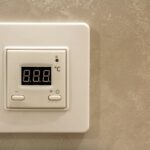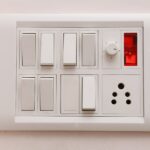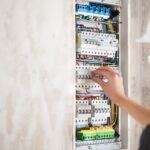Picture this: you’re in the middle of a busy evening, appliances humming in symphony when suddenly, darkness sets in as your circuit breaker trips. This common yet frustrating issue can disrupt your home’s functionality and compromise its safety. Understanding what causes a circuit breaker to trip isn’t just about restoring power; it’s about safeguarding your home and peace of mind.
- Explore how electrical overloads, short circuits, and ground faults can disturb your electrical system.
- Learn practical steps to diagnose power disruptions and prevent future outages effectively.
- Discover how to safely use multimeters and other tools for efficient troubleshooting.
By diving into the intricacies of your home’s electrical system, you’ll gain the know-how to tackle tripping circuit breakers head-on, ensuring safety and functionality in your daily life. This article will empower you to address these inconveniences confidently, highlighting when it might be time to call in a pro. Let’s get started on ensuring a shock-free home!
Understanding Why Your Circuit Breaker Keeps Tripping: Identify Overload and Resolve Common Causes
If you’ve ever asked yourself, “Why does my circuit breaker keep tripping?” you’re not alone. This common electrical problem can be both frustrating and confusing. At the heart of most issues is an electrical overload, but there are other culprits to consider, such as short circuits and ground faults.
Electrical overload occurs when a particular circuit is forced to carry a higher electrical load than it’s designed for. This is often due to plugging in too many high-power appliances at once. As new electrical appliances are added to our homes, the strain on circuits can cause your breaker to trip.
Short circuits are another frequent cause, usually resulting from faulty wiring or a damaged appliance. They create a low-resistance path, allowing excessive current flow through, leading to potential fire hazards. Meanwhile, ground faults are similar but occur when the current makes contact with the ground, leading to unintended pathways.
Understanding these issues is crucial, as they not only interrupt your daily routine but can also pose serious safety risks. Begin diagnosing the problem by identifying the specific circuits that trigger the breaker. Check if there are visible signs of damage or overheating, ensuring to disconnect any appliances that might contribute to these faults.
Identifying Electrical Overloads: Causes and Solutions
Electrical overloads represent one of the most frequent reasons for circuit breakers tripping. But how do these overloads occur? Typically, they arise when a circuit is tasked with handling more electricity than its capacity. This often happens in older homes where wiring systems weren’t designed to handle modern power demands.
Signs of an overload may include frequent tripping, flickering lights, or buzzing sounds from outlets. Also, if you notice your breaker tripping when multiple appliances are used simultaneously, an overload is likely the culprit.
To effectively resolve overloads, start by redistributing power usage. Unplug heavy-duty appliances and balance their load across different circuits. Alternatively, consider upgrading your electrical system to accommodate increased demand. This not only prevents overloads but also ensures a safer and more efficient power supply throughout your home.
Addressing overloads is essential for preventing interruptions and safeguarding your appliances. Always remember, if you’re unsure about handling electrical issues, professional help can provide comprehensive solutions and peace of mind.
Troubleshooting Your Electrical System: Circuit Breaker Keeps Tripping? Identify and Resolve Common Causes
Dealing with a circuit breaker that keeps tripping can be frustrating and potentially hazardous. It’s crucial to employ effective troubleshooting techniques to pinpoint the root cause of this electrical issue. By understanding the problem, you can take the necessary steps to ensure your home’s electrical system functions safely and efficiently.
First, begin by visually inspecting the circuit breaker panel. Check for any obvious signs of damage or loose connections, which could indicate an underlying problem. If everything appears intact, proceed with a systematic approach to identify specific circuits contributing to the tripping.
Using a multimeter is a crucial step in diagnosing electrical problems. This versatile tool helps measure voltage, current, and resistance, offering valuable insights into the performance of your electrical system. To use a multimeter effectively, follow these steps:
Set the multimeter to the appropriate measurement setting and carefully follow the manufacturer’s instructions. Start measuring the voltage across your circuits, ensuring all electrical devices are disconnected. Look for inconsistencies that might suggest a faulty circuit or device.
If the circuit breaker trips only when specific appliances are in use, it’s likely an overload issue. Reduce the load or redistribute devices to different circuits to prevent repeated tripping. Ground faults and short circuits may require a professional electrician for diagnosis and repair.
Throughout the troubleshooting process, prioritize electrical safety. Avoid handling electrical components with wet hands and ensure power is shut off before examining the circuit breaker panel. If you encounter complex issues or cannot identify the cause, seek the expertise of a licensed electrician.
By applying these troubleshooting techniques, you’ll be better equipped to tackle the common causes of a tripping circuit breaker. Restore peace of mind by keeping your home’s electrical system in top condition, and don’t hesitate to reach out for professional assistance when necessary.
FAQ: Troubleshooting a Tripping Circuit Breaker
What does it mean when a circuit breaker keeps tripping?
A tripping circuit breaker indicates an electrical issue such as overload, short circuit, or ground fault that needs attention.
How can I tell if my circuit breaker is overloaded?
Signs of an overload include frequent tripping, flickering lights, and devices shutting off unexpectedly. Reduce load or upgrade the circuit.
What tools can help diagnose a tripping breaker?
A multimeter is essential for checking voltage and current to diagnose electrical issues safely.
What should I do if my circuit breaker trips repeatedly?
First, unplug non-essential devices, then reset the breaker. If it trips again, consult an electrician.
Can a homeowner fix a tripping breaker themselves?
Simple troubleshooting can be done at home, but recurring issues should be addressed by a professional.
Is a constantly tripping breaker dangerous?
Yes, it can signify underlying electrical faults, which may present fire risks or hurt appliances if left unresolved.





